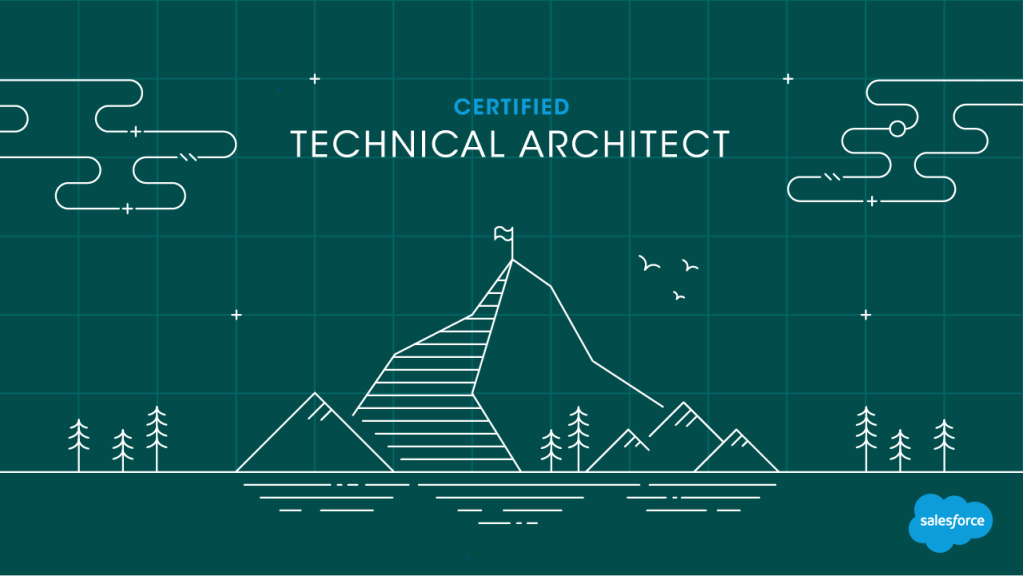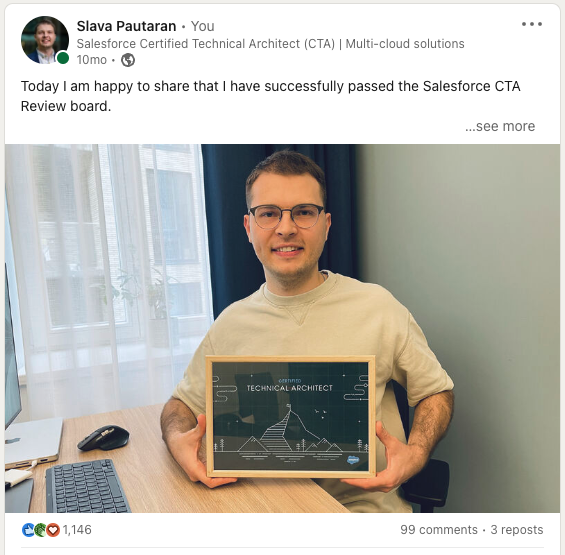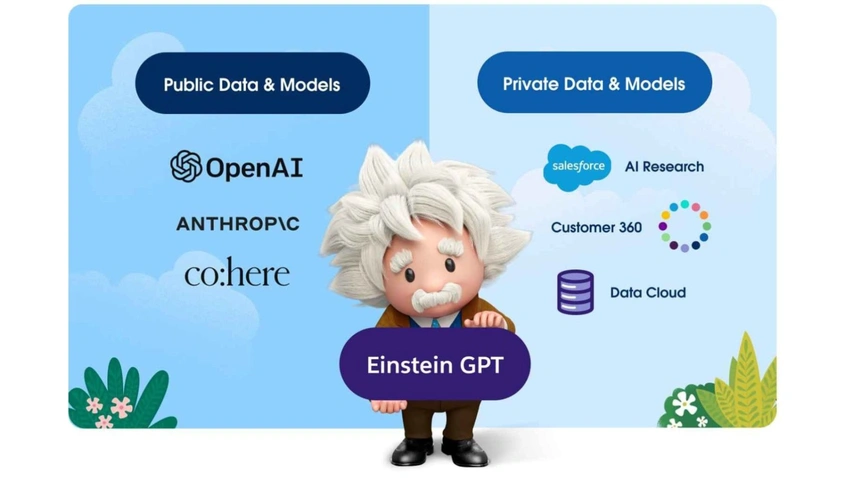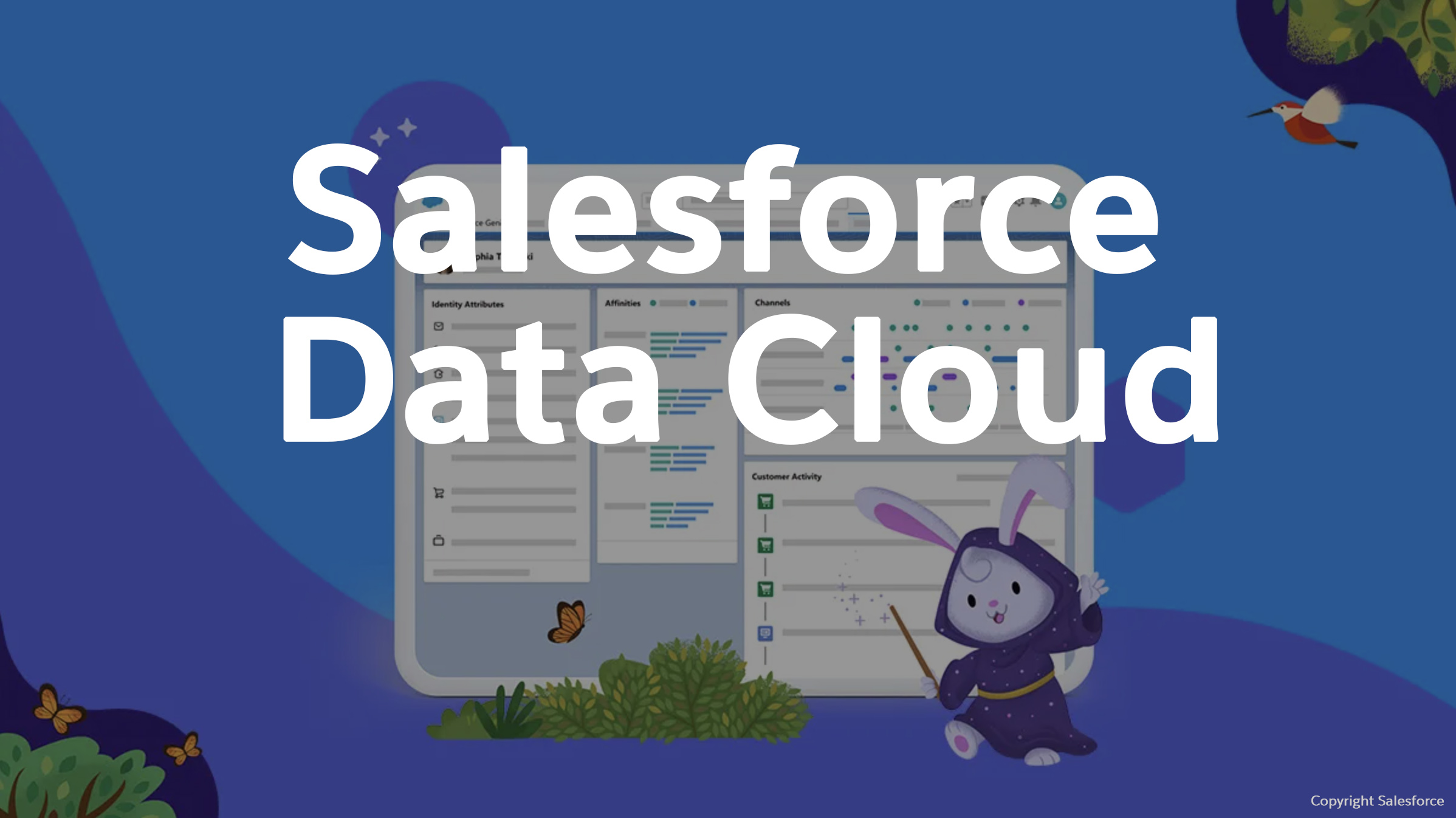
In September 2022, after investing over 1000 hours in studying and preparation, conquering more than 50 mock exams, I’ve successfully completed the journey that I embarked on back in 2020, I achieved the rarest of accomplishments in the Salesforce ecosystem – becoming a Salesforce Certified Technical Architect (CTA).
There are now only nearly 500 individuals worldwide out of over 70.000 certified Salesforce specialists, making it less than 0,01%. This is the most challenging exam in the Salesforce ecosystem and one of the most challenging and prestigious certifications in the global technology industry.
Salesforce describes CTAs as trusted experts with a strategic mindset and unique experience solving business challenges in digital transformation, who communicate directly with CXOs of large companies and deliver high-quality end-to-end solutions.
In this article, I will tell more about the exam itself and will share some of my tips. I will also describe the importance of the certification for the enterprise platforms.
Enterprise platform certifications
Certifications exist across various fields, offering validation of a specialist’s level of expertise.
For companies, certifications play a pivotal role in finding the right individuals during the hiring process, ensuring a skilled and knowledgeable workforce.
For architects and consultants, certifications hold equal importance, whether they work in the service/consulting IT industry or in large organizations. Getting certified unlocks several opportunities:
- Deepening your understanding of the platform’s capabilities and developing practical skills in solutioning architectural and business challenges within enterprise ecosystems.
- Meeting new people, studying for the same certification
- Unlocking exciting career and growth opportunities.
Salesforce CTA Exam, Review Board
The Salesforce CTA exam has been around for about 10 years and it is constantly improving to bring out the best architects. The whole exam lasts about 7 hours with 3 breaks of 15 minutes.
The exam consists of 3 parts:
- Solving a Hypothetical Business Scenario
- Presenting your solution
- Questions and Answers with Review Board judges
The most up-to-date information can be found at the link.
Solving a Hypothetical Business Scenario
A business scenario is a comprehensive document spanning multiple pages, providing an overview of a hypothetical company, along with specific details about its business objectives and goals. Within this scenario, you’ll find a description of the company’s current IT systems, the users accessing these systems, their customers, and partners. The document outlines the requirements that need addressing, and as an architect, your task is to propose solutions for these challenges.
The exam assumes that Salesforce products can address most of these challenges, and it evaluates candidates based on their ability to utilize Salesforce platform capabilities in combination with other solutions & tools to solve the scenario’s requirements.
This portion of the exam involves creating essential diagrams that will support your solution presentation, including Data Model, System Landscape, Development Lifecycle, Data Migration, Project Governance, and more. We’ll delve into these details further in the solution presentation section.
Candidates have a time limit of 3 hours (3:30 for non-native English speakers) for this section, designed to assess how well they can navigate and perform effectively under the pressure of compressed time constraints.
During the solution preparation phase, you are restricted to using only Google Docs, Google Slides, Google Spreadsheets, and paper and pen for creating diagrams.
Presenting your solution
45 minutes are allotted for the presentation of the solution for review board members consisting of 3 examiners/judges. During this time the candidate must cover many aspects that describe their solution in detail.
I will provide a list of questions that each and every CTA has to think about and address as part of their solution and presentation.
Systems and business applications
- Which existing business applications are to be decommissioned?
- What new applications and systems should you implement?
- Will the Salesforce implementation be used in each region, or will it be a global implementation?
- What will be the mobile solution for customers and employees of the company?
- How will the documents be stored?
- How will reporting and analytics be carried out?
Solution Security
- Which platform features will be utilized to ensure data security and compliance with the standards & regulations in specific regions/industries?
- What principles and approaches will be applied to protect data during integrations?
- What will be used for data storage?
Data model
- What approaches allow the system to process large amounts of data without losing performance?
- How will the data be archived?
- How will data be migrated from legacy third-party systems?
- How will the standard platform data model be used?
Solutions for Scenario Requirements
- Which of the tasks should be solved using customization using code?
- What can be done using the platform’s point-and-click capabilities?
- What can be solved by bringing solutions from AppExchange?
Integrations
- What is your integration strategy?
- For each integration, which pattern does it follow?
- Which APIs are you going to use?
- How are you handling authentication & authorization between systems?
- How do you manage user identity?
- How do you allow Single Sing On (SSO)?
Project implementation
- How are you structuring communication between different development tracks?
- How to prevent unforeseen changes in the scope, and delays in the project timeline?
- How often will there be releases?
- How will the development process be technically organized?
- What tools will be used to make the development process manageable and efficient?
- How should the team working on the project be organized (on the part of the customer and the contractor) in order for the project to be completed successfully?
The evaluation focuses on the solution’s ability to meet customer requirements, the quality of diagrams and presentation, time management, and the correctness of proposed solutions.
Within a tight timeframe, candidates must address all solution requirements comprehensively, formulating their thoughts concisely and accurately.
Q&A
A panel of three examiners, all of whom hold CTA certification, take turns asking questions to ensure the proposed solutions are correct, well-reasoned, and aligned with the client’s scenario requirements.
Candidates are allotted 45 minutes for this segment (1 hour for non-native English speakers). During this section, the candidate has the opportunity to justify or correct their solutions during that time.
Conclusion
I hope you found this blog post informative and interesting.
If you are an aspiring CTA, who has completed CTA pre-requisites and is ready to start presenting and judging mock exams, feel free to apply to the study group that I’m now co-organizing. If you’d like to have me as a CTA coach or mock exam judge, send me a message.
If you are a real business in search of a CTA-level architect to drive your projects and support your organization, feel free to reach out to me. I have a vast network of CTA friends who can join forces to bring valuable expertise and solutions to your ventures. Together, we can propel your business to new heights with top-notch Salesforce knowledge and skills.




